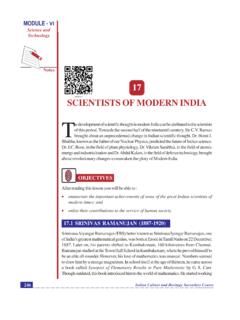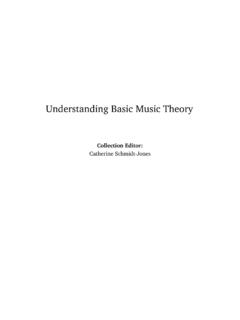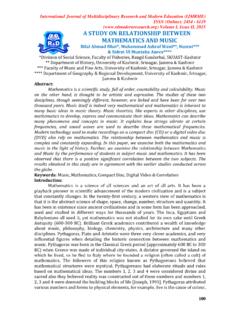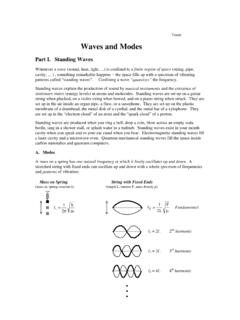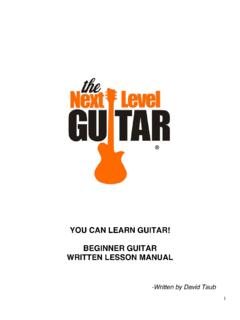Transcription of Understanding Basic Music Theory - opentextbooks.org.hk
1 Understanding Basic MusicTheory Catherine Schmidt-JonesPrinting HistoryFebruary 2015:Adopted by Open Textbooks SystemThis work is licensed under a Creative Commons-ShareAlike International LicenseOriginal source: 1 The The Groups of Treble Clef and Bass Memorizing the Notes in Bass and Treble Moveable Why use different clefs?.. Pitch: Sharp, Flat, and Natural Key Enharmonic Enharmonic Enharmonic Keys and Enharmonic Intervals and Enharmonic Spellings and Equal Duration: Note Lengths in Written The Shape of a The Length of a More about Duration: Rest Time Beats and Meter: Reading Time Counting and What is Meter?
2 Classifying Recognizing Pickup Notes and Pickup Pickup Dots, Ties, and Borrowed Dotted Tied Borrowed Metronome Tempo Gradual Tempo Repeats and Other musical Road Map Dynamics and What is Articulation?.. Performing Common Solutions to Exercises in Chapter 2 The Shape or Contour of a Melodic Melodic Melodies in Suggestions for Presenting these Concepts to Terms that Describe Suggested Some useful Vocal Instrumental Classifying Western and Jazz, Blues, and World Tonal, Atonal, and Modal Classical and Art Folk and Popular Suggestions for Listening and Further Tonal, Atonal.
3 And Modal Western Non-Western Western Non-Western Music that Combines Western and Non-Western 3 The Physical Acoustics for Music Music is Organized Sound Longitudinal and Transverse Wave Amplitude and Wavelength, Frequency, and Standing Waves and musical What is a Standing Wave?.. Standing Waves on Standing Waves in Wind Standing Waves in Other Harmonic Series I: Timbre and physics , Harmonics and The Harmonic Solution to Exercises in Chapter 4 Notes and Octaves and the Major-Minor Tonal Where Octaves Come Naming Dividing the Octave into Half Steps and Whole Major Keys and Tonal Major Music in Different Minor Keys and Music in a Minor Minor Relative Minor and Major Harmonic and Melodic Minor Jazz and Dorian Minor.
4 The Distance Between Naming Classifying Perfect Major and Minor Augmented and Diminished Inverting Harmonic Series II: Harmonics, Intervals and Frequency and Brass Playing Harmonics on The Circle of Related Key Scales that aren t Major or Scales and Western Pentatonic Dividing the Octave, More or The Blues Modes and Exotic Solutions to Exercises in Chapter 5 Harmony and Triads in Root First and Second Naming Major and Minor Augmented and Diminished Consonance and Beyond Triads.
5 Naming Other Chord Seventh Added Notes, Suspensions, and Bass Altering Notes and Beginning Harmonic Basic Triads in Major A Hierarchy of Naming Chords Within a Minor Further Form is the Basic Describing Labelling Form With Naming Solutions to Exercises in Chapter 6 Ear What is Ear Training?.. Ear Training Playing Chords By Playing Tunes by Recognizing Intervals and Writing Music Tuning Tuning based on the Harmonic Pythagorean Mean-tone Just Well Equal A Comparison of Equal Temperament with the Harmonic Beats and Wide Further Modes and The Classical Greek The Medieval Church Modal Jazz and Folk The Ragas of Classical Indian Other Non-Western Modal Transposition: Changing Why Transpose?
6 Avoiding How to Transpose Step 1: Choose Your Step 2: Write the New Key Step 4: Be Careful with Choosing Your New Working with Transposing Playable Transposing at Transposing Chord Step 1: Choose Your Step 2: Change the Names of All the Solutions to Exercises in Chapter underCreative Commons-ShareAlike International License( ).Although it is significantly expanded from "Introduction to Music Theory ", this coursestill covers only the bare essentials of Music Theory . Music is a very large subject, andthe advanced Theory that students will want to pursue after mastering the basics willvary greatly.
7 A trumpet player interested in jazz, a vocalist interested in early Music , apianist interested in classical composition, and a guitarist interested in world Music ,will all want to delve into very different facets of Music Theory ; although, interestingly,if they all become very well-versed in their chosen fields, they will still end up verycapable of Understanding each other and cooperating in musical endeavors. The finalsection of this course does include a few challenges that are generally not considered"beginner level" musicianship, but are very useful in just about every field and genreof main purpose of the course, however, is to explore Basic Music Theory sothoroughly that the interested student will then be able to easily pick up whateverfurther Theory is wanted.
8 Music history and the physics of sound are included to theextent that they shed light on Music Theory . Students who find the section onacoustics (The Physical Basis) uninteresting may skip it at first, but should then goback to it when they begin to want to understand why musical sounds work the waythey do. Remember, the main premise of this course is that a better Understanding ofwhere the basics come from will lead to better and faster comprehension of morecomplex also helps to remember, however, that Music Theory is a bit like are invented by the people who speak them, who tend to care more aboutwhat is easy and what makes sense than about following rules.
9 Later, experts studythe best speakers and writers in order to discover how they use language. Theselanguage theorists then make up rules that clarify grammar and spelling and point outthe relationships between words. Those rules are only guidelines based on patternsdiscovered by the theoreticians, which is why there are usually plenty of "exceptions"to every rule. Attempts to develop a new language by first inventing the grammar andspelling never seem to result in a language that people find Theory , too, always comes along after a group of composers and performershave already developed a musical tradition.
10 Theoreticians then study the resultingmusic and discover good ways of explaining it to the audience and to other composersand performers. So sometimes the answer to "Why is it that way?" is simply "that'swhat is easiest for the performer", or "they borrowed that from an earlier musictradition".In the case of Music , however, the answers to some "why"s can be found in the basicphysics of sound, so the pivotal section of this course is an overview of acoustics as itpertains to Music . Students who are already familiar with notation and Basic musicaldefinitions can skip the first sections and begin with this introduction to the physicalbasis of Music .


